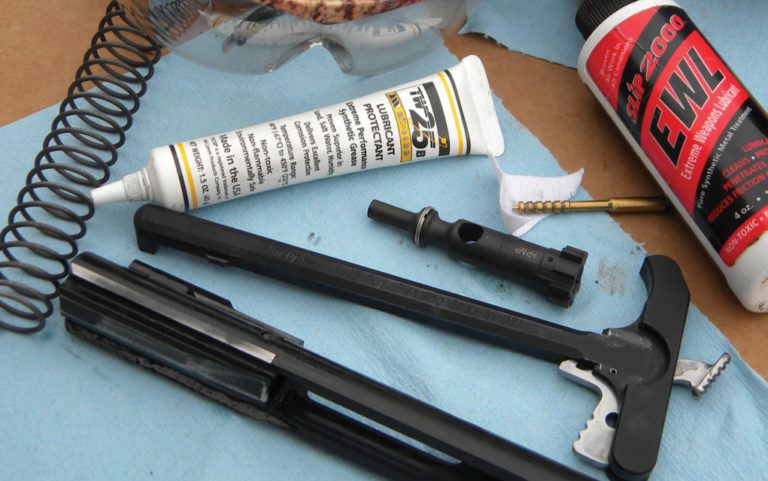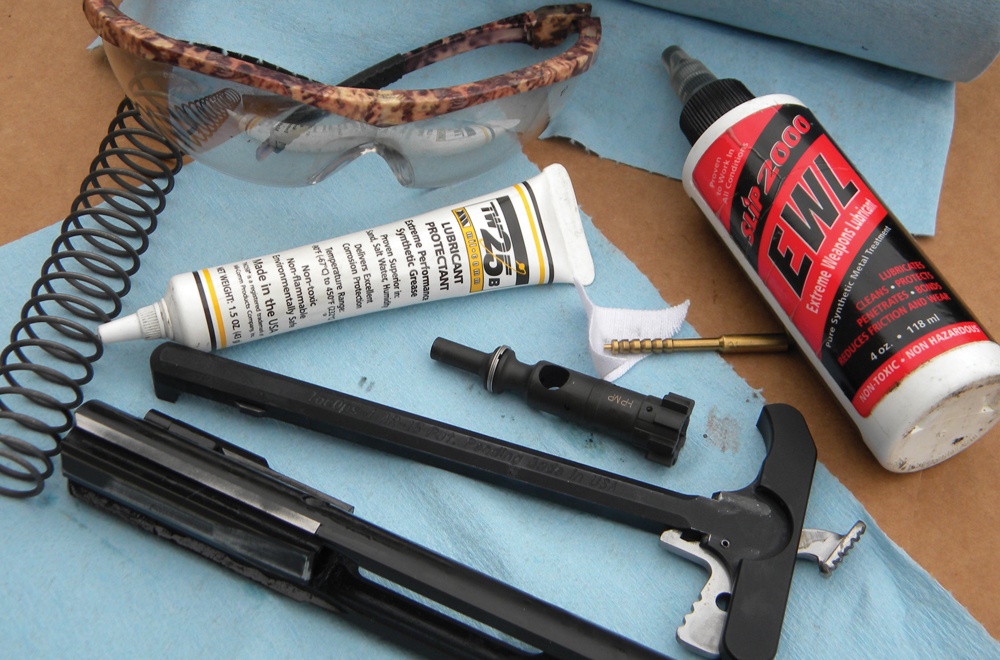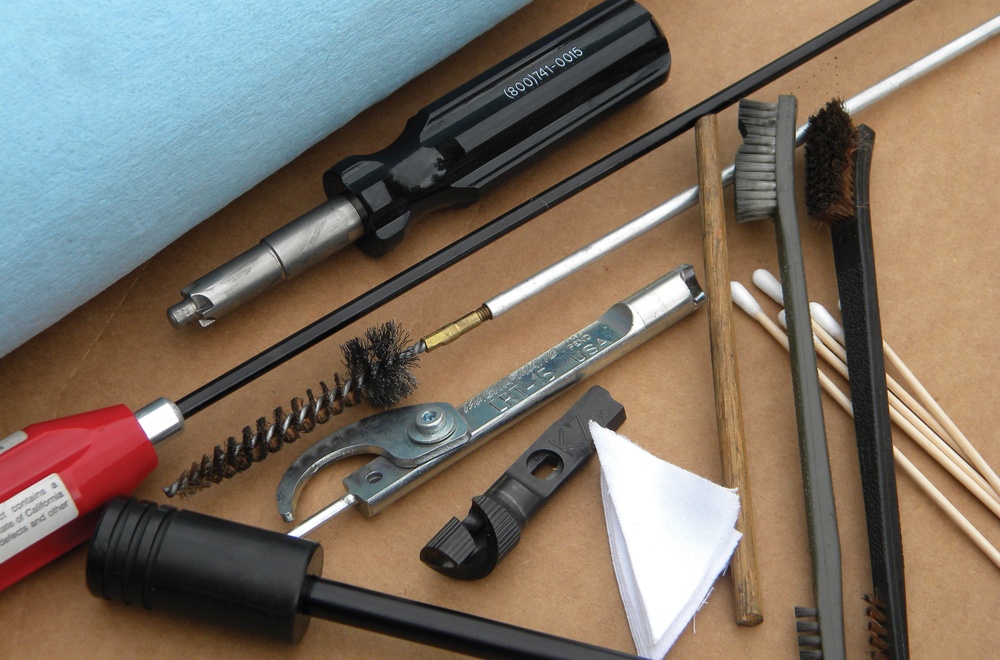
The AR is a highly reliable firearm — as long as the shooter maintains it properly.
If you take care of your rifle it will take care of you:
- Must-Have Tackle
- Efficient And Effective Cleaning Tips
- Lube For The Long Haul
- General Maintenance Guidelines And Tactics
The AR is basically an internal combustion engine. Instead of gasoline, it runs off gunpowder, which burns dirtier than gas. With cleaning and lubrication, the AR will serve you well, always ready for use. Or, if it’s going into the safe for winter, you’ll want to make sure it’s prepped for long-term storage.
To properly clean the AR, you’ll need some specialty pieces of equipment. Can you clean it with your standard packaged kit? In an emergency, anything will probably do. But, the AR is a little different than Granddad’s huntin’ rifle.
Must-Have Tackle
First, get a good cleaning rod. I use Dewey rods, which are nylon coated with a rotating ball-bearing handle. The coating prevents carbon and residue from impregnating the rod, which ends up damaging the barrel. The handle allows the rod to rotate on the rifling as it travels down the bore. Segmented steel or aluminum rods and “snakes” are for field use only.
Use a bore guide. This is a tube that goes into the upper receiver and seats into the chamber. As you push the rod down the barrel — always travel in the same direction the bullet goes — the guide prevents damage to the chamber and throat. I use a jag to hold patches, as opposed to a loop. With a loop — think about the eye of a large sewing needle — there’s a chance the loop will rub against the bore. The patch goes around the jag so there is less chance of this happening.
You’ll also need a chamber brush. The barrel extension — rear of the barrel that contains the chamber — has female lugs that the male lugs of the bolt seat into. This area gets a lot of residue built up and must be cleaned to maintain reliability and accuracy. The chamber brush is the only way to clean it well.
Be sure to get a tool for cleaning the bolt and bolt carrier, too. This is much more efficient than doing it by hand. An upper receiver cleaning kit has a large rod, brush and mop to clean the upper receiver where the bolt carrier rides. High-quality patches and cleaning swabs are a must. You don’t want lint and little strings inside your engine. Over the years, I’ve collected various wood dowels and “sticks” that I put patches on to clean small, tight areas. Eventually, you’ll figure out what works best for you.
Efficient And Effective Cleaning Tips
I start by cleaning the chamber, using the chamber brush and my specialty tools. Cleaning the barrel first and then the chamber will just reintroduce grime back into the clean barrel, and then you have to start over.

Ask 20 shooters how they clean the barrel and you’ll get 30 different answers. Everyone has their way, and almost none are the same. When I clean the barrel, I want to remove all carbon and powder residue but leave the copper in the bore’s microscopic imperfections. The copper build up in the small hills and valleys makes the bore smoother. If you clean that out, it has to build back up once you start shooting again. However, if the gun is going into the safe for a long time, I will use Hoppes to clean out the copper and then heavily lube everything prior to storage.
To clean the barrel, I use Break-Free’s CLP cleaner and patches on a jag. I run a wet patch with CLP down the bore, followed by dry patches. After each pass, I pull the rod out and wipe it down. Once the dry patches are coming out clean, I repeat the process several times. Once everything is coming out clean, I lube the barrel with SLIP 2000 EWL oil. If the rifle is going to sit for a while, I’ll leave the barrel “wet” with oil. With my work rifles, I’ll run one dry patch through to collect any excess oil.
Never attempt to clean the gas tube. This gets cleaned when the high-pressure gas travels through it. Trying to clean it will only create more trouble. If it’s questionable, then replace it.
Lube For The Long Haul
Lubrication is critical for the AR. I have an AR — one of the Shootrite Katanas built by MHT — that has more than 20,000 rounds through it without ever having been cleaned, but it does get lubricated regularly. I don’t recommend this for a work rifle; however, it proves that an AR will run dirty but it won’t run dry.
Lubes break down into two categories: grease and oil. Over time, grease will start to gum or cake up. Oil will eventually start to wick whichever way gravity is pulling it and evaporate. I use a combination of both — Mil-Comm’s TW25B grease and Slip 2000 EWL oil. When combined, the oil keeps the grease from solidifying and the grease prevents the oil from wicking and evaporating. I start by putting on grease, working it into the pores of the metal. The SLIP oil goes over that.
You want to lubricate any areas that see friction. On the bolt, the lugs and the raised shoulder about midway back get grease and oil. For the gas rings, ejector and extractor, I’ll put a drop of oil only. A little oil on the back of the bolt, behind the gas rings, will make it easier to clean. The bolt carrier has raised shoulders where it rides in the receiver, the bottom where it resets the hammer and the gas key on top that rides in the channel of the charging handle. Look at the carrier and you’ll see wear marks on these areas. They get grease and oil, as do the cam pin and firing pin.
One area that people tend to forget is the buffer spring. Remove the buffer and spring, clean the buffer tube and lube the spring. On the trigger group, I put one drop of oil on each side of the hammer and trigger pins — where the springs are — a drop on the disconnector and the bottom hook of the hammer. Too much lube on the trigger group will just attract more gunk.
The charging handle is also a big source of friction. Lube the sides and top, which are the areas in contact with the upper receiver, with grease and oil.
General Maintenance Guidelines And Tactics
While cleaning and lubing, always inspect all parts for wear or breakage. This includes checking the extractor and ejector springs, gas rings and making sure the gas key on top of the bolt carrier hasn’t worked loose. The key is staked in place, but if it’s not properly staked it can work loose.
For fieldwork, you should have a small, compact cleaning kit, along with lube. It’s also a good idea to have a few spare parts like the firing pin retaining pin, a cam pin, gas rings, extractor spring and firing pin. These parts are small and easily lost, or if there’s a part breakage, you can get the rifle up and running again very quickly.

How often should you clean your AR? That depends on how many rounds you’ve fired, how dirty the power burns and the temp and humidity. How long should it take to clean your AR? A thorough cleaning takes me about 45 minutes — and that’s to clean, inspect, lube and reassemble.
As the Marine Corps’ Rifleman’s Creed says, “I will keep my rifle clean and ready, even as I am clean and ready. We will become part of each other.”
Take good care of your AR, and it will always be ready for any challenge you ask it to overcome.
This article originally appeared in the December 2017 issue of Gun Digest the Magazine.

Next Step: Get your FREE Printable Target Pack
Enhance your shooting precision with our 62 MOA Targets, perfect for rifles and handguns. Crafted in collaboration with Storm Tactical for accuracy and versatility.
Subscribe to the Gun Digest email newsletter and get your downloadable target pack sent straight to your inbox. Stay updated with the latest firearms info in the industry.


![Best Concealed Carry Guns In 2025 [Field Tested] Wilson Combat EDC X9S 1](https://gundigest.com/wp-content/uploads/Wilson-Combat-EDC-X9S-1-324x160.jpg)


![Best 9mm Carbine: Affordable PCCs [Tested] Ruger Carbine Shooting](https://gundigest.com/wp-content/uploads/Ruger-Carbine-Shooting-100x70.jpg)
![Best AR-15: Top Options Available Today [Field Tested] Harrington and Richardson PSA XM177E2 feature](https://gundigest.com/wp-content/uploads/Harrington-and-Richardson-PSA-XM177E2-feature-100x70.jpg)
